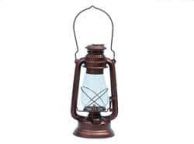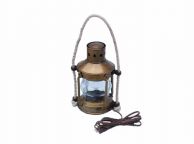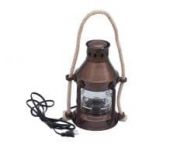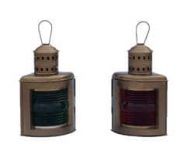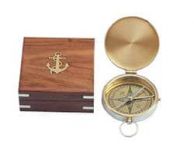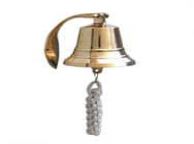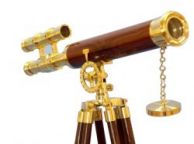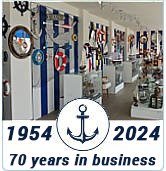|
|
| (21 Items) Sort: |
Similar to Nautical Lighting Models
Nautical Lighting Models
Any of our table, desk or cabin lanterns is perfectly suited to display on a shelf or mantle in an office, den or parlor, where they add a classic ambiance, and many are available in both lustrous polished brass as well as antiqued finishes. Several wall-mounted or hanging lanterns offer appealing décor uses indoors as well as outdoor functionality on a patio or in a yard.
Specialized nautical lanterns, such as a ship’s port and starboard running lamps or anchor-line marker lamps, make excellent and recognizable additions to a collection of nautical décor for any room or setting.
Simple oil lamps appeared over 6,000 years ago, and consisted of little more than a bowl filled with a flammable liquid that had a fluid-soaked wick hanging out one end. The wick was ignited and oil was drawn through it to burn similar to the functioning of a candle. Throughout the millennia that followed the shape and style of the lamp was slightly refined and many artistically decorated and highly ornate lamps were produced in every culture from a variety of materials, but the basic design remained unchanged. The drawback of both candles and lamps was their open flame, which were vulnerable to wind and weather which would cause it to flicker or even risk extinguishing it. Moreover, the exposed flame was a severe hazard and fire risk, especially for an oil lamp that fell and spilt the contents of its reservoir across the carpet of a room or the wood planked decks of a ship. Early candle lanterns were little more than boxes to enclose single candles within a protective housing with sides of clear glass or mica. These protected the candle from flickering (and people from some burns), and could be carried with little risk of accidentally snuffing the flame as one moved about a room, hall or street. However, the oil lamp remained largely unchanged until nearly 1800, when the first glass-enclosed chimney-style lamp was introduced. Invented by Aimé Argand, the “Argand Lamp” placed a tubular wick between metal rings and channeled air flow around and through it to increase the efficiency of combustion and brightness of the flame. A glass chimney surrounded the wick to protect the flame as well as aid airflow, while high-quality oil was gravity-fed from a separate reservoir. The Argand Lamp provided light equal to 6-10 candles, and despite its cost and relative complexity its use spread quickly. It was in 1850 that a new type of lantern was introduced that quickly superceded the traditional oil-burning lamp and became the model for all types following it until the introduction of electricity. Fueled by kerosene that was light enough to be pulled from a reservoir below through a wick by capillary action rather than requiring a cumbersome gravity-fed upper supply, these new lanterns proved brighter, more efficient, less mechanically complex and readily portable. The basic design of a kerosene lantern features a reservoir at the bottom to both hold the fuel and provide a stable base, above which is mounted a mechanism for holding and adjusting the position of the wick, and thereby the brightness of the lantern. A fluted glass chimney (or “globe”) surrounds the wick to protect the flame, but since the chimney has a smaller diameter at the top than the bottom, it also aids in air-flow, drawing cool oxygen-rich air in through the bottom to feed the flame and exhausting hot, burned gasses out the top. Table and desk lanterns varied greatly in size and design, based upon the needs and affluence of their owner. Wall-mounted lanterns could supply light to an entire room, and specialized versions were adapted for nearly every imaginable purpose. Lanterns with handles could be carried to light a person’s way or hung out-doors during the evening. Work lamps gained added protection of their fragile glass globes with the addition of metal cages to protect them from impacts, manufacturing the globe in the pattern of a fresnel lens allowed light from signal or marker lanterns to be visible from great distances. Several specialized nautical lantern designs were developed for use on ships. While any type of lanterns aboard a ship might help signal its presence to other vessels, a specific system of red and green lights to indicate the port (left) and starboard (right) side of a boat helped mariners determine the speed and bearing of other vessels as well as determine right-of-way to help avoid collisions. Specialized lanterns were also developed to hang on masts or anchor lines to mark their locations and help avoid accidents. Among the most specialized lanterns produced were the miners lamps developed for use on coal mines. Deep within the earth of a working mine, the presence of natural gasses such as methane as well as coal-dust raised raise from mining meant that the air the miners were breathing could itself be flammable or even explosive. In 1815 two different types of “safety lamp” were introduced for use in mines. Using either a tight wire mesh or a protective globe to keep the flame from reaching the outside air and igniting an explosion, these lamps sought to protect the lives of the men working at this dangerous labor. One interesting feature of the safety lamps is that by watching how their flame burned, the miners could detect the build-up of both methane and carbon-dioxide before either gas reached dangerous levels that could result in asphyxiation. Oil and kerosene lamps remained in general use until the wide-spread introduction of electricity in the Victorian era. They remained commonplace lighting sources in remote areas and rural regions even well into the 20th century, and are still used by some campers. They continue to serve not only as a reliable source of emergency illumination in the event of electrical power outage, but offer a pleasing and nostalgic ambient mood lighting for many occasions.
 Handcrafted
Handcrafted Handcrafted
Handcrafted Handcrafted
Handcrafted Handcrafted
Handcrafted Handcrafted
Handcrafted Handcrafted Model Ships
Handcrafted Model Ships









